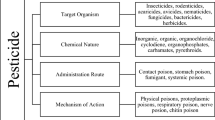Abstract
The biodegradation capacity of indigenous microbial populations was examined in a desert soil contaminated with crude oil. To evaluate biodegradation, soil samples supplemented with 5, 10 or 20% (w/w) of crude oil were incubated for 90 days at 30 °C. The effect of augmentation of the soil with vermiculite (50% v/v) as a bulking agent providing increased surface/volume ratio and improved soil aeration was also tested. Maximal biodegradation (91%) was obtained in soil containing the highest concentration of crude oil (20%) and supplemented with vermiculite; only 74% of the oil was degraded in samples containing the same level of crude oil but lacking vermiculite. Gas chromatograms of distilled fractions of crude oil extracted from the soil before and after incubation demonstrated that most of the light and part of the intermediate weight fractions initially present in the oil extracts could not be detected after incubation. Monitoring of microbial population densities revealed an initial decline in bacterial viable counts after exposure to oil, presumably as a result of the crude oil’s toxicity. This decline was followed by a steep recovery in microbial population density, then by a moderate increase that persisted until the end of incubation. By contrast, the inhibitory effect of crude oil on the fungal population was minimal. Furthermore, the overall increased growth response of the fungal population, at all three levels of contamination, was about one order of magnitude higher than that of the bacterial population.
Similar content being viewed by others
References
Al-Daher R, Al-Awadhi N, El-Nawawy A, (1998) Bioremediation of damaged desert environment using the windrow soil pile system in Kuwait. Environ. Int. 24: (1–2): 175–180
ASTM 5307D (1999) American Society for Testing and Materials (ASTM) “Standard test method for determination of boiling range distribution of crude petroleum by gas chromatography”. In: Annual Books of ASTM Standards Section 5 – Petroleum Products, Lubricants and Fossil Fuels, Volume 05.03, ASTM, West Conshohocken, PA
Atlas RM (1984) Petroleum Microbiology. Maximillian Publishing Company
Britton LN, (1984) Microbial biodegradation of aliphatic hydrocarbons. In: Gibson DT, (Ed) Microbial Degradation of Organic Compounds, Marcel Dekker, New York, (pp 89–129)
Capelli SM, Busalmen JP, de-Sanchez SR, (2001) Hydrocarbon bioremediation of a mineral-base contaminated waste from crude oil extraction by indigenous bacteria Int. Biodeterior. Biodegrad. 47: 233–238
Delille D, Delille B, Pelletier E, (2002) Effectiveness of bioremediation of crude oil contaminated sub-Antarctic intertidal sediment Microbial Ecol. 44:118–126
Gogoi BK, Dutta NN, Goswami P, Krishna Mohan TR, (2003) A case study of bioremediation of petroleum-hydrocarbon contaminated soil at a crude oil spill site Adv. Environ. Res. 7:767–782
Joergensen RG, Schmadeke F, Windhorst K, Meyer B, (1995) Biomass and activity of microorganisms in a fuel oil contaminated soil Soil Biol. Biochem. 27:1137–1143
Korda A, Santas P, Tenent A & Santas R (1997) Petroleum hydrocarbon bioremediation: Sampling and analytical techniques, in situ treatments and commercial microorganisms currently used. Appl. Microbiol. Biotech. 48: 677 686
Lawrence AN, Milind DD (1995) Simulated distillation of oils with a wide carbon number distribution J. Chromatogr. Sci. 33:133–138
Lehay JG, Colwell RR, (1990) Microbial degradation of hydrocarbons in the environment Microbiol. Rev. 54:305–315
Loosdrecht MCM, Lyklema W, Norde W, Zehnder AJB, (1990) Influences of interfaces on microbial activity. FEMS Microbiol. Rev. 54: 75–87
Moeller J, Winther P, Lund B, Kirkebjerg K, Westermann P, (1996) Bioventing of diesel oil-contaminated soil: comparison of degradation rates in soil based on actual oil contamination and resprometric data J. Industrial Microbiol. 16:110–116
Obuekwe CO, Hourani G, Radwan SS, (2001) High temperature hydrocarbon biodegradation activities Kuwaiti desert soil samples Folia Microbiol. 46:535–539
Palittapongarnpim M, Pokethitiyook P, Upatham ES, Tangbanlueka L, (1998) Biodegradation of crude oil by soil microorganisms in the tropics Biodegradation 9:83–90
Pineda-Flores G, Boll Arguello G, Lira-Galeana C, Mesta-Howard AM, (2004) A microbial consortium isolated from a crude oil sample that uses asphaltenes as carbon and energy source Biodegradation 15: 145–151
Rahman KSM, Banat IM, Thahira J, Thayumanavan T, Lakshmanaperumalsamy P, (2002) Bioremediation of gasoline contaminated soil by a bacterial consortium amended with poultry litter, coir pith and rhamnolipid biosurfactant Bioresource Technol. January 81(1): 25–32
Rosenberg E, Navon-Venezia S, Zilber-Rosenberg I & Ron EZ (1998) Rate-limiting steps in the microbial degradation of petroleum hydrocarbons. In: Rubin H, Narkis N&Carberry J (Eds) Soil and Aquifer Pollution, (pp 159 172). Springer-Verlag, Berlin, Heidelberg
Rhykerd RL, Crews B, McInnes KJ, Weaver RW, (1999) Impact of bulking agents, forced aeration, and tillage on remediation of oil-contaminated soil Bioresource Technol. March 67(3): 279–285
Rhykerd RL, Sen D, McInnes KJ, Weaver RW, (1998) Volatilization of crude oil from soil amended with bulking agents Soil Sci. 163: 87–92
Singer ME, Finnerty WR, (1984) Microbial metabolism of straight-chain and branched alkanes. In: Atlas RM, (Ed) Petroleum Microbiology, Macmillan, New York, pp 1–59
Straube WL, Jones-Meehan J, Pritchard PH & Jones WR (1999) Bench-Scale optimization of bioaugmentation strategies for treatment of soils contaminated with high molecular weight polyaromatic hydrocarbons. Resour. Conserv. Recy. 27: 27 37
U.S. Environmental Protection Agency–Analytical method 1664. (1999) http://www.epa.gov/waterscience/methods/1664f051.html)
Author information
Authors and Affiliations
Corresponding author
Rights and permissions
About this article
Cite this article
Embar, K., Forgacs, C. & Sivan, A. The role of indigenous bacterial and fungal soil populations in the biodegradation of crude oil in a desert soil. Biodegradation 17, 369–377 (2006). https://doi.org/10.1007/s10532-005-9007-9
Accepted:
Published:
Issue Date:
DOI: https://doi.org/10.1007/s10532-005-9007-9




